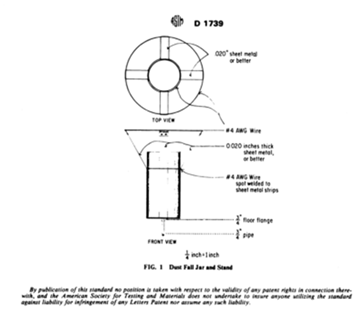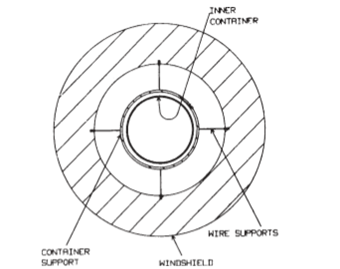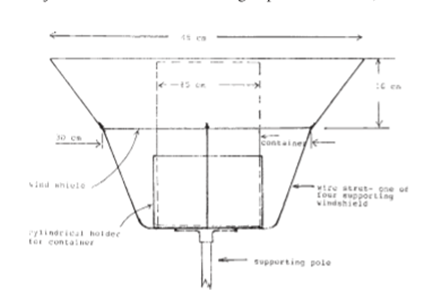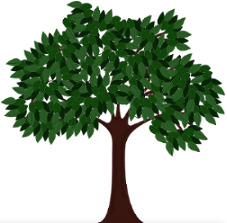Posted on: 7 June 2016
In the South African context dust fallout monitoring is outlined in the dust control regulations ![]() of November 2013. In this regulation it specifies that "the method to be used for measuring dustfall rate and the guideline for locating sampling points shall be ASTM D1739: 1970, or equivalent method approved by an internationally recognised body". This statement has been contested a lot due to the fact that the ASTM D1739: 1970 method is no longer available online through ASTM.
of November 2013. In this regulation it specifies that "the method to be used for measuring dustfall rate and the guideline for locating sampling points shall be ASTM D1739: 1970, or equivalent method approved by an internationally recognised body". This statement has been contested a lot due to the fact that the ASTM D1739: 1970 method is no longer available online through ASTM.
Collector / Bucket
First is the collector specifications. The ASTM D1739: 1970 method refers to an open topped cylinder with vertical sides and a flat bottom. It states that the cylinder should be 150mm in diameter and two to three times the depth. The ASTM D1739: 98 (2010) methods states the same but the height is no less than twice the diameter.
Stand design
The stand design is the most debated aspect of the method. In the ASTM D1739: 1970 it specifies that the holder should not interfere with the operation of the collector in any way and a bird ring shall be provided as seen in Figure 1 below. It also states that the top of the container shall be a minimum of 8 feet above the ground (2,4m). The ASTM D1739: 98 (2010) however states that the top of the container shall be 2m above the ground and that it will include a wind shield as shown in Figure 2 and Figure 3 below.



Water vs no water
In the ASTM1739: 1970 it states that when preparing the container you should place distilled water in the container so that the level is half of the collector's depth. In warm climates you should add sufficient copper sulphate as an algaecide to give 15 mg/litre concentration. It also states that the collector liquid should be kept at a reasonable level during the test period. In the ASTM D1739: 98 (2010) it does not specify that water needs to be added to the bucket or does it mention whether algaecide needs to be added to the bucket. The only reference to reagent water in the method is with regards to cleaning the buckets after sample analysis.
Field sampling
With regards to handling of collected samples both the ASTM D1739: 1970 and the ASTM D1739: 98 (2010) state that no attempt should be made to remove collected particulate sample from the collector at the field site. Collectors shall then be covered and taken to the laboratory for analysis of the content.
Analysis type
In the ASTM D1739: 1970 it outlines the procedure for total water insoluble. It should be reported as settle able particles which is reported in grams per square meter per month. In the ASTM D1739: 98 (2010) it however includes the procedure for insoluble matter as well as total soluble matter.
Exito Environmental Projects
Exito Environmental Projects are experts in the field of dust fallout monitoring. For more information on dust fallout monitoring please contact us
Table 1: Summary of the differences in methods
| ASTM D1739: 1970 | ASTM D1739: 2010 | |
|---|---|---|
| Container | Open topped cylinder with vertical sides and a flat bottom, minimum 15cm diameter with depth of 2 - 3 times diameter | Open topped cylinder with vertical sides and a flat bottom, minimum 15cm diameter with depth of twice diameter |
| Stand design | Bird ring design as per Figure 1 | Design including windshield as per Figure 2 and Figure 3 |
| Water vs no water | Distilled water in the container so that the level is half of the collector's depth as well as algaecide. | No reference to water to be added to the sampler. |
| Field sampling | No attempt should be made to remove collected particulate sample from the collector at the field site. | No attempt should be made to remove collected particulate sample from the collector at the field site. |
| Analysis type | Total water insoluble. | Total water insoluble matter as well as total soluble matter. |
References
Department of Environmental Affairs, National Environmental Management: Air Quality Act, 2004, National Dust Control Regulations, November 2013.
ASTM D1739 - 98 (Reapproved 2010), Standard Test Method for Collection and Measurement of Dustfall (Settleable Particulate Matter).
ASTM D1739 - 70, Standard Method for Collection and Analysis of Dustfall (Settleable Particulates)
